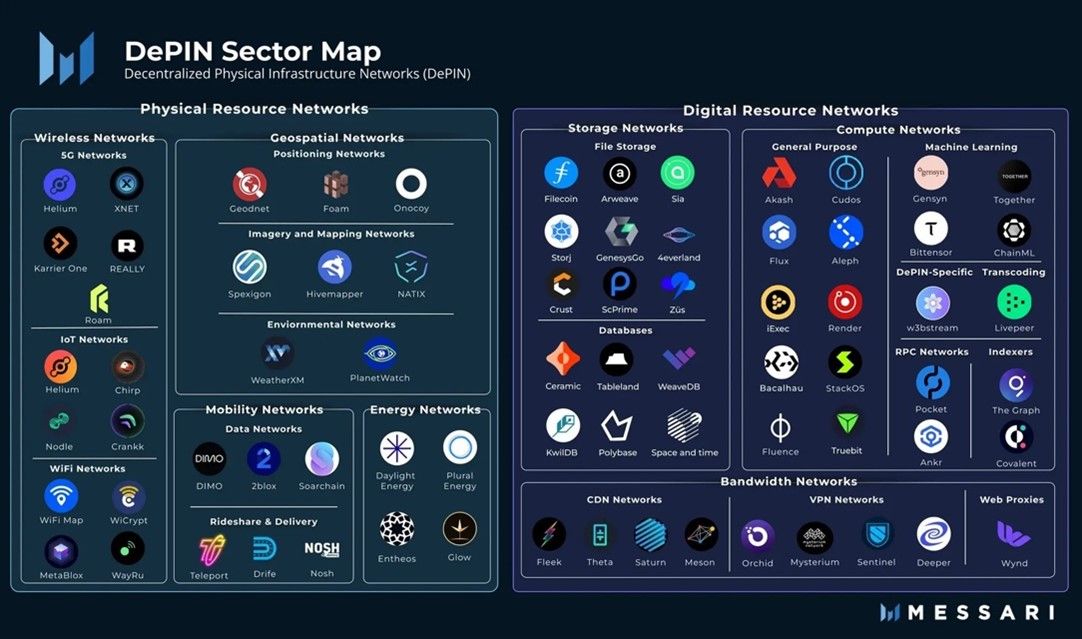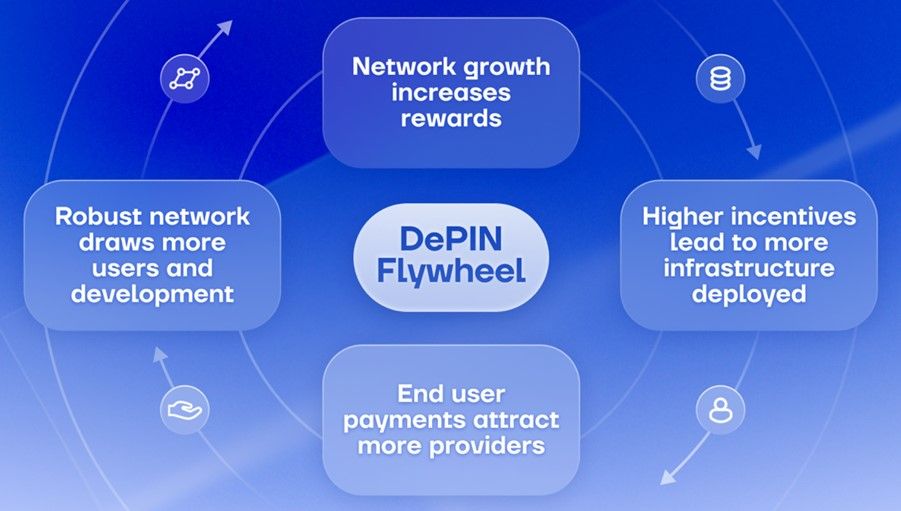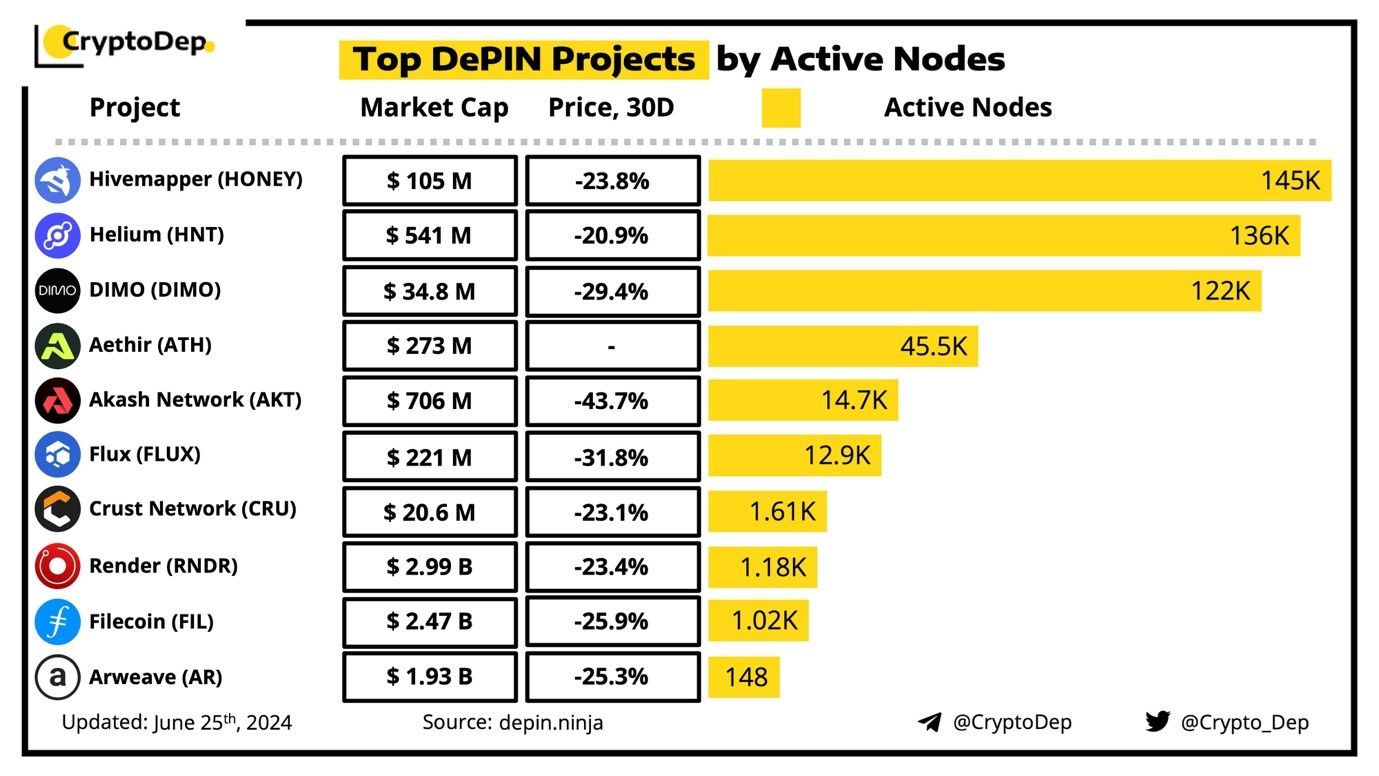Recently, we talked about the RWA sector and its high potential for growth this cycle. DePIN is another sector that has been performing well with room for growth in the future. According to DePINscan, the DePIN category saw a 42% increase in market cap (year to date).
Today, we share our thoughts on this sector and also some interesting projects that have potential to multiply in the long term.
What is DePIN?
Decentralized Physical Infrastructure Networks (DePIN) refers to networks that bring together and share services or resources with users, effectively balancing supply and demand.
DePINs cover a wide range of areas and can be divided into two main types: physical infrastructure networks and digital resource networks. Examples of these include storage, computing, artificial intelligence, wireless networks, and mapping services. These networks make it easier to access and use resources more efficiently across different sectors.

Source: Messari
How do they work?
DePIN uses blockchain technology to distribute control and management across a network, rather than having it centralized in one organization. These networks operate in various fields, including energy, supply chains, telecommunications, data storage, transportation, and real estate.
In DePIN, control is shared among many users instead of being held by a single authority. Every transaction is recorded on a blockchain, making it transparent and secure. People who contribute to these networks are often rewarded with crypto or digital tokens, which motivates them to participate.
These tokens can be traded, sold, or used within the network, adding value for the contributors. This ensures the infrastructure is maintained in a decentralized way, with no single entity in control. The widespread participation supports the network’s growth and ensures its resilience and sustainability. The more participants there are, the stronger and more efficient the network becomes, leading to continuous improvement.

Source: Google
How does it help DeFi?
DePIN significantly enhances DeFi by leveraging blockchain technology and crypto to remodel infrastructure management and financial services.
• Accessibility to all investors
DePIN makes infrastructure investment available to many by opening projects to a wider range of investors. In the past, these opportunities were mainly for big corporations and institutional investors. Now, with tokenized assets, smaller investors can also take part. For example, Energy Web uses EWT tokens to invest in renewable energy.
• Enhancing security
DePIN improves the security and resilience of DeFi (Decentralized Finance) protocols by decentralizing essential components like wireless networks and data storage.
For example, Filecoin provides decentralized data storage, which increases security and availability. Users rent out their unused storage space, creating a distributed network.
• Promoting Sustainable Finance
DePIN projects encourage sustainable finance by promoting the use of renewable energy and eco-friendly infrastructure. DePIN tokens can be used in carbon markets, helping companies offset their emissions by investing in renewable energy projects.
For example, Veridium Labs uses blockchain to trade tokenized carbon credits. This helps companies offset their emissions and achieve their sustainability goals.
Is DePIN infrastructure solving real world problems? Yes!
• Telecom: DePIN provides a unique solution for communication in areas with limited telecommunication infrastructure by enabling direct peer-to-peer (P2P) connections without relying on centralized service providers. For example, the Helium Network is advancing telecom innovation by allowing individuals and businesses to set up wireless hotspots. This creates a decentralized network that offers internet connectivity in regions with scarce infrastructure.
• Urban Development: DePIN can work with smart city projects to create new DeFi opportunities by decentralizing the management and financing of urban infrastructure. By tokenizing assets like power grids and transportation networks, these assets can be traded or used as collateral on DeFi platforms.
• Supply-chain administration: DePIN creates decentralized networks for supply chains, enabling logistics companies to track deliveries in real-time and manage operations efficiently. For example, VeChain uses blockchain technology to improve supply chain management. It allows logistics companies to monitor deliveries live and run their operations smoothly.
How can you benefit from this trend? Invest in top DePIN tokens!

Source: https://twitter.com/Crypto_Dep/status/1805579582982025404/photo/1
We cover three key DePIN projects that you must consider investing in.
• Render Network: Render is a high-performance distributed GPU rendering network. Render Network allows GPU owners to loan out their GPU power to creators in need of GPU power. The protocol can also be seen as a solution to render high-quality graphics and train LLMs.
• Filecoin: Filecoin is the largest decentralized data storage marketplace. It enables users with excess data storage to trade available space to users needing storage space for a fee. In 2023, its storage utilization grew dramatically to 20% from 3%.
• Helium: Helium is a fast-growing decentralized wireless network. By deploying a Helium Hotspot anywhere in the world, you can provide others with wireless network coverage. In exchange for doing this, you're rewarded with Helium tokens.
Key Takeaway
DePIN is set to revolutionize the Web3 ecosystem by decentralizing infrastructure management and promoting crypto adoption. It allows more users to take part in infrastructure projects, reducing costs and challenging monopolies. While the full financial benefits are still being realized, DePIN has already proven to be cost-effective, benefiting users, providers, and projects alike.
Imagine a future where resilient, efficient, and community-driven infrastructure thrives in areas like energy, telecommunications, transportation, healthcare, and education.
We strongly believe in this narrative. Do you?
Not subscribed to Cryptogram yet? Subscribe here
Disclaimer: Crypto products and NFTs are unregulated and can be highly risky. There may be no regulatory recourse for any loss from such transactions. Please do your own research before investing and seek independent legal/financial advice if you are unsure about the investments.
